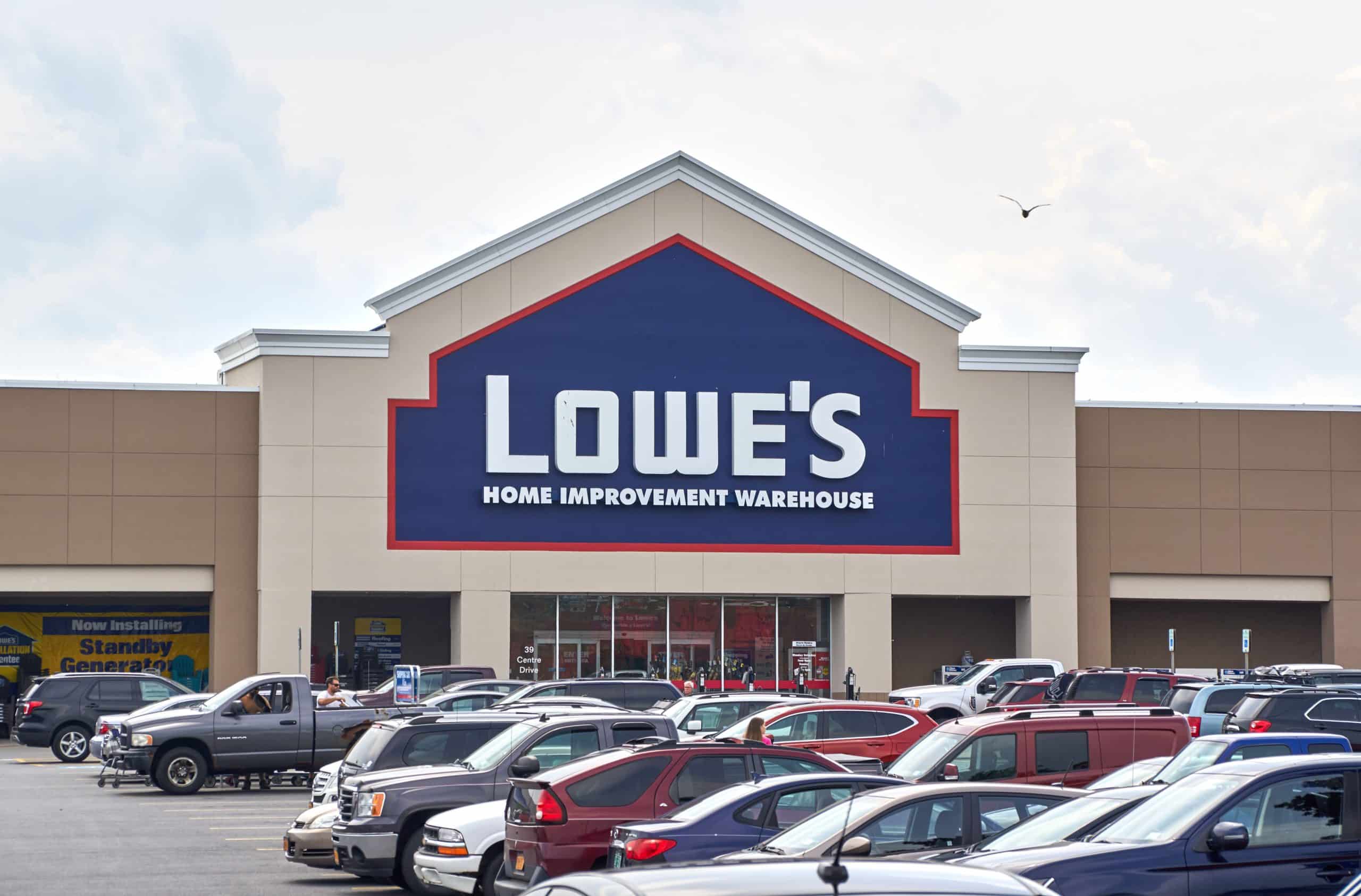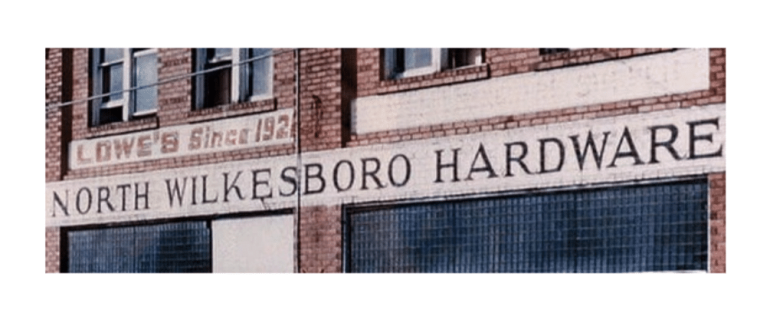After a century of economic ups and downs, Lowe’s is one of the leading home improvement retailers in the US.
In November 2024, Lowe’s has a net worth of $149.45 billion.
To get to the bottom of its success, our statistical experts at Business2Community have completed thorough research to produce this article. Lowe’s net worth and history reveal a lot about its effective expansion strategies, especially when facing economic challenges.
Lowe’s Key Company Data
Lowe’s Net Worth: $149.45 billion
Date Founded: 1921
Founded by: Lucius Smith Lowe
Current CEO: Marvin R. Ellison
Industries: Retail
Lowe’s Stock Ticker: NYSE: LOW
Dividend Yield: 1.77%
What is Lowe’s Net Worth?
As of November 2024, Lowe’s net worth, also known as market cap, stands at $149.45 billion with a stock price of $273.19 and 567 million shares outstanding.
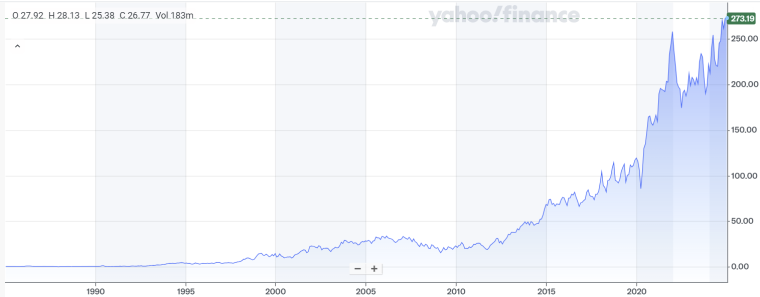
Lowe’s held its initial public offering in 1961, selling 400,000 shares at $12.25 per share on the first day of trading. For nearly two decades, Lowe’s stock was traded over the counter. It wasn’t until 1979 that it was listed on the New York Stock Exchange (NYSE) under the ticker symbol LOW.
During the late 20th century and early 21st century, the US experienced a housing boom. Before the real estate bubble burst, Lowe’s was benefiting from the growing economy as a home improvement retailer. Lowe’s net worth climbed from $17 billion at the beginning of 2000 to $51.41 billion in January 2007, more than tripling in value.
Over half of its market cap evaporated during the Great Recession in 2008, falling to $23.28 billion in February 2009 from its 2007 peak before gradually recovering as the economy improved. By the end of 2019, its net worth was $91.79 billion.
When COVID-19 sent many businesses to the brink of bankruptcy, leading home improvement retailers like Home Depot and Lowe’s enjoyed a surge in demand as homebound consumers looked for DIY projects to pass the time. In 2020, Lowe’s saw a 106% year-to-year increase in digital sales. Its net worth also reached $100 billion by July 2020 and continued to soar to $174.15 billion in January 2022.
As restrictions eased and people returned to the office, Lowe’s 2022 Q1 sales dropped by 3% compared to 2021 Q1. However, its main competitor Home Depot was able to maintain the COVID-19-fueled growth. Analysts believed this was because “Home Depot is still the destination of choice”.
Lowe’s net worth dipped from its peak in January 2022 to $110.23 billion six months later.
Lowe’s financial year ends on February 2 with quarterly and full-year reports available on its website within the next quarter.
Lowe’s Revenue
In 1979, the year after Lowe’s was listed on the NYSE, it had an annual revenue of $905 million. Since then, it’s been on a stable growth trajectory, especially during the late 1990s to the early 2000s due to the growing housing bubble. By 2007, Lowe’s sales reached $47.28 billion.
Although the Great Recession caused Lowe’s revenue to fall to $47.22 billion in 2009, the decline was small compared to other industry players, thanks to Lowe’s building materials segment, which saw a strong boost as residents of the Gulf Coast rebuilt from hurricane damage.
The retail titan continued to grow, reaching $72.15 billion in sales in 2019 before welcoming one of its fastest-growing periods. COVID-19 pushed up revenue considerably for Lowe’s. Between March 2020 and August 2021, Lowe’s experienced double-digit growth rates for every quarter. Its 2020 annual revenue increased by $15 billion from the previous year, amounting to $89.60 billion. By 2022, its sales were $97 billion.
@lowes Dad level: 1000. #LowesGoals @goodlyearth
However, before Lowe’s could achieve its first-ever $100 billion sales year, the growth facilitated by the pandemic was easing as people’s lives returned to normal. Its 2023 annual sales fell to $86.38 billion.
| Year | Revenue ($ billions) |
| 2014 | 56.22 |
| 2015 | 59.07 |
| 2016 | 65.02 |
| 2017 | 68.62 |
| 2018 | 71.31 |
| 2019 | 72.15 |
| 2020 | 89.60 |
| 2021 | 96.25 |
| 2022 | 97.06 |
| 2023 | 86.38 |
Lowe’s Dividend History
Lowe’s paid its first dividend in October 1980 at $0.14 per share. Since then, it has been paying dividends quarterly, even during the Great Recession.
As of November 2024, Lowe’s has a trailing twelve-month (TTM) dividend payout of $4.60 and a dividend yield of 1.77%.
Over the years, Lowe’s conducted 5 stock splits with the last one in 2006. If you purchased one share prior to the first stock split in 1992, it would turn into 32 shares today after the multiple splits.
| Date | Stock Price ($) | Dividend Payout ($) | Dividend Yield (%) |
| 01/21/2020 | 111.05 | 1.94 | 1.75 |
| 04/21/2020 | 85.56 | 2.02 | 2.36 |
| 07/21/2020 | 134.45 | 2.03 | 1.51 |
| 10/20/2020 | 164.76 | 2.08 | 1.26 |
| 01/19/2021 | 159.43 | 2.41 | 1.34 |
| 04/20/2021 | 189.88 | 2.19 | 1.15 |
| 07/20/2021 | 182.52 | 2.43 | 1.33 |
| 10/19/2021 | 210.35 | 2.63 | 1.25 |
| 01/18/2022 | 225.73 | 2.83 | 1.25 |
| 04/19/2022 | 193 | 3.03 | 1.57 |
| 07/19/2022 | 180.44 | 3.28 | 1.82 |
| 10/18/2022 | 185.67 | 3.52 | 1.90 |
| 01/24/2023 | 199.37 | 3.79 | 1.90 |
| 04/25/2023 | 199.88 | 4.05 | 2.02 |
| 07/25/2023 | 228.19 | 4.12 | 1.80 |
| 10/24/2023 | 182.73 | 4.19 | 2.29 |
| 01/23/2024 | 211.51 | 4.26 | 2.01 |
| 04/23/2024 | 231.42 | 4.33 | 1.78 |
| 07/24/2024 | 230.69 | 4.40 | 1.91 |
| 10/23/2024 | 270.11 | 4.47 | 1.65 |
Who Owns Lowe’s?
Lowe’s is owned by both institutional and individual investors. The Vanguard Group (9.59%), BlackRock Inc. (6.86%), and JP Morgan Chase 4.63%), are the three biggest shareholders.
Lowe’s opened its doors in 1921, with a single store focused on hardware and building materials. By 1961, the company had flourished into a 15-store chain and gone public, selling 400,000 shares at $12.25 each on the first trading day.
As of March 2024, Lowe’s shares traded near their 52-week high of $248.55, closing at $243.48. Over the last few decades, the big box format retailer’s stocks have appreciated by over 1,880%, highlighting strong market performance, and financial health.
Who is Lowe’s CEO?
Marvin Ellison is the CEO of Lowe’s. He took over from Robert Niblock in 2018, to become the first African American CEO of Lowe’s. Taking charge two years before the company’s 100th anniversary, Ellison focused on business goals like:
- Operational efficiency.
- Omnichannel retail.
- Supply chain management.
- DEI strategies within the Lowe’s corporate ranks.
- Increasing market share.
Under his leadership, the company’s annual revenue increased from $71 billion in 2019 to nearly $100 billion in 2022 and 2023.
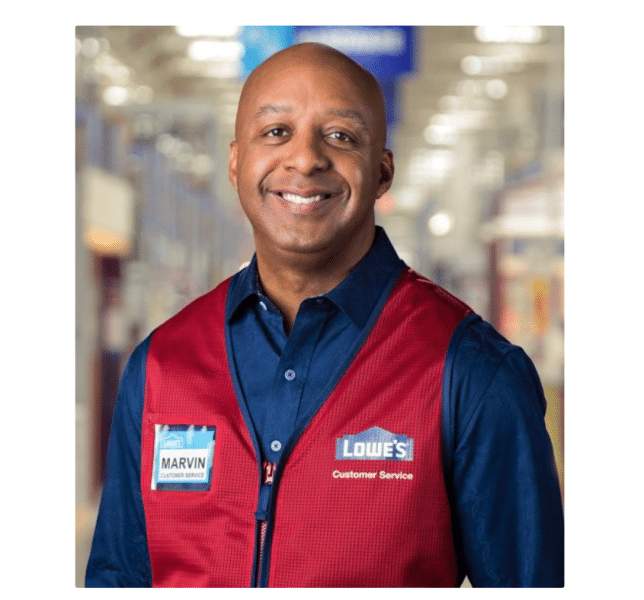
In 2022, Lowe’s CEO received compensation of $17.5 million, down from his 2021 salary package of $17.9 million. His compensation consisted of 8.3% in salary and 91.7% in bonuses, including company stock and options. In addition, Ellison owns 0.039% of the company’s shares, valued at $58.12 million.
| Period | CEO Name |
| 1946 – 1952 | L.S. Lowe |
| 1952 – 1960 | Carl Buchan |
| 1960 – 1961 | Jim Lowe |
| 1961 – 1978 | Robert Strickland |
| 1978 – 1996 | Leonard Herring |
| 1996 – 2005 | Robert Tillman |
| 2005 – 2018 | Robert Niblock |
| 2018 – Present | Marvin Ellison |
Growth and Development of Lowe’s
Lowe’s Companies, headquartered in North Carolina, is the second largest home improvement retailer after Home Depot. Through its 1,738 home improvement stores in the US and online channels, Lowe’s offers a comprehensive range of products at everyday low prices, across categories such as:
- Lumber and building materials
- Tools, hardware, and appliances
- Fashion fixtures
- Rough plumbing and electrical
- Seasonal and outdoor living
- Lawn and garden
- Paint
- Millwork
- Flooring
- Kitchens
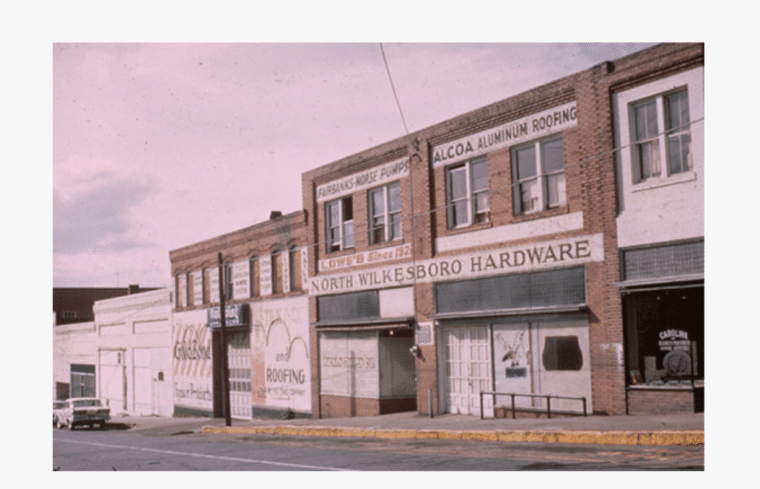
A History of Lowe’s – Key Dates
- The company’s success story began in 1921 when L.S. Lowe opened the first store called Lowe’s North Wilkesboro Hardware.
- Lowe’s was incorporated in North Carolina in 1952 and has been publicly held since 1961.
- Initially targeting building contractors, Lowe’s revamped its entire marketing strategy and sales mix to cater to DIY retail customers in 1990.
- In 2010, Lowe’s took its operations international with stores in Mexico.
- In its 100th year of operation, Lowe’s joined Fortune’s Top 50 All-Star list of the World’s Most Admired Companies.
1921 – 1945: Foundation and Early Expansion
It all started in 1921 when Lucius Smith Lowe, a farmer and former rural mail carrier, opened the first Lowe’s store in his hometown of North Wilkesboro, North Carolina.
Together with hardware and building materials, the neighborhood hardware store also sold sewing notions, dry goods, horse tack, snuff produce, and groceries.
In 1940, after L.S. Lowe died, James Lowe, aka Jim, his son, took over the hardware store. After serving in World War II, J. Lowe offered his brother-in-law, Carl Buchan, part ownership in the company.
1946 – 1949: Post-War Growth and Focus Shift
In 1946, Carl Buchan shifted the company’s focus from the hardware business to home improvement products, anticipating an increase in construction after World War II. Through his leadership and business acumen, the company had bought a second store, in Sparta, North Carolina by 1949.
1950 – 1958: Nationwide Expansion Begins
Carl Buchan became the sole owner of Lowe’s in 1952, ending his joint ownership with James Lowe. While James Lowe started the Lowes Foods grocery store chain, Carl pressed on with plans to turn Lowe’s into a national chain. In 1955, Lowe’s opened additional stores in Durham, Asheville, and Charlotte. By 1958, Lowe’s had 344 associates and had shifted its focus from DIY customers to pros.
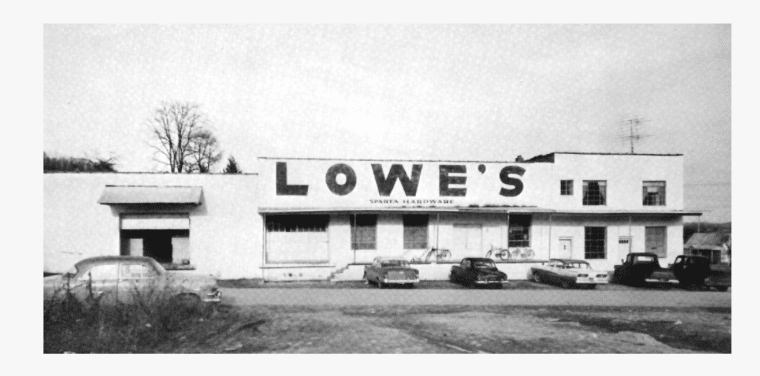
1960 – 1979: Public Listing and Market Repositioning
By 1960, Lowe’s had grown into a chain of 15 stores. Following the sudden death of Carl Buchan, a five-man executive team, which included Robert Strickland and Leonard Herring, led Lowe’s transition to a publicly traded company.
On October 10, 1961, Lowe’s Companies Inc. debuted on the stock market, offering 400,000 shares at $12.25 each. The chain’s growth continued with 21 stores and annual revenues of $32 million by 1962. In 1964, Lowe’s announced that it had served an estimated one million customers annually for the first time.
When Robert Strickland took on the title of CEO in 1978, he revamped the marketing strategy, choosing to target individual consumers and households with a DIY model. Lowe’s concentrated on selling appliances, hardware, and construction materials.
Strickland’s move paid off, ushering in a new era of growth for Lowe’s. The company’s success was further cemented when Lowe’s began trading on the New York Stock Exchange in 1979.
Throughout the 1970s, Lowe’s experienced significant financial growth, raking in revenues exceeding $150 million. By 1979, this had increased to a staggering $904 million in annual revenues.
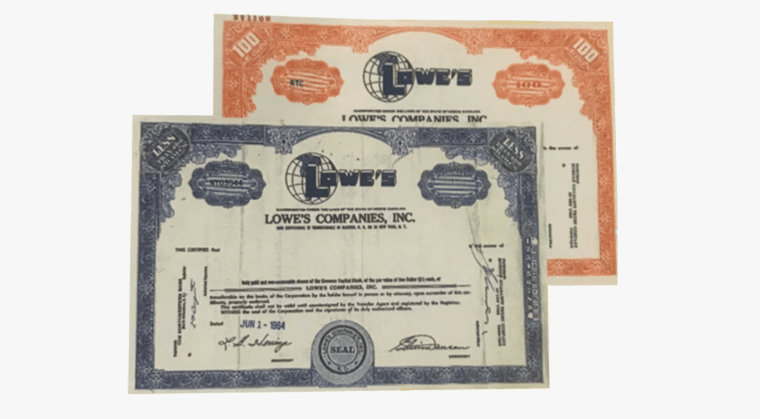
1980 – 1989: Diversification and Rapid Growth
By 1980, under the leadership of CEO Leonard Herring, Lowe’s operated a total of 209 retail stores in 19 states. Each store combined the merchandise, service, and functions of a:
- Lumberyard
- Building materials supplier
- Heating, air conditioning, plumbing, and electrical supply center
- Hardware store
- Home electronics and appliances dealer
- Hard goods discounter
- Professional marketing company
In 1981, the company began trading on the London Stock Exchange and embarked on an ambitious revamping program called RSVP. The program reflected the changing marketplace where retail customers increasingly accounted for a larger share of the company’s total sales.
Lowe’s achieved its first billion-dollar sales year and earned a profit of $25 million in 1982, marking the start of yet another prosperous era. By 1989, Lowe’s had grown by another 100 stores to 309 locations across 20 states and pulled in annual revenue of over $2.6 billion.
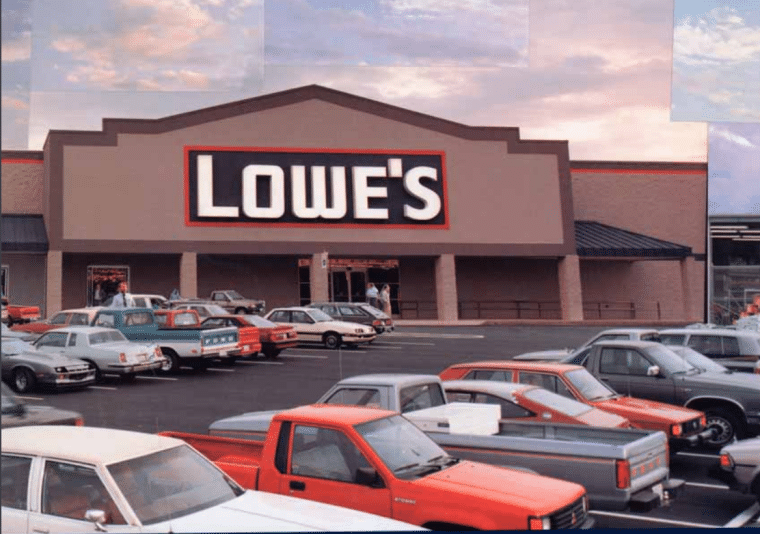
1990 – 1999: Big-Box Retailing and Online Move
By 1990, retail customers accounted for 66% of total sales. Initially, building contractors accounted for 70% of Lowe’s total sales, then 48% in 1984. In just six short years, Lowe’s managed to achieve a 14% customer base shift along with $2.8 billion in sales.
While Lowe’s didn’t have a store larger than 33,000 square feet in 1984, by early 1990, the average sales floor size had doubled, exceeding 45,000 square feet. When 1994 came around, Lowe’s stores were large warehouses of more than 85,000 square feet, featuring tools, building supplies, and home decorations.
In 1995, the company reported annual revenues of $7 billion, and Lowe’s launched Lowes.com, marking the company’s entrance into the digital market. By 1996, Lowe’s had undergone a major transformation, from a chain of small stores to a big-box format retailer designed to serve the fast-growing home improvement market.
Lowe’s purchased the Wilkes Mall in Wilkesboro, North Carolina, to serve as the company’s corporate headquarters in 1998 and Robert Tillman took over as CEO.
In 1999, the company acquired Eagle Hardware & Garden Company, a regional home improvement retailer in the Pacific Northwest. The acquisition added 47 stores to Lowe’s portfolio and expanded its presence in the western United States.
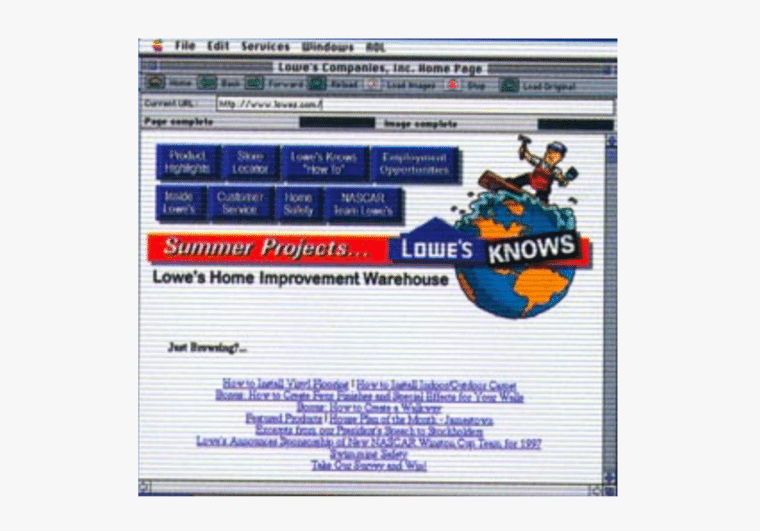
2000 – 2009: Aggressive Expansion and Economic Challenges
In 2000, Lowe’s embarked on its most aggressive expansion plan, opening 100 new stores. It also relaunched a new and improved Lowes.com. By 2001, Lowe’s was opening more than two new superstores per week.
Lowe’s joined the Fortune 100 for the first time with $22 billion in revenue in 2002. In 2003, Lowe’s opened an additional 130 stores, bringing its store count to 952.
Robert Niblock, a 25-year veteran of Lowe’s, was appointed as CEO in 2005. Through his leadership, sales management, and store expansion program, the company had record revenues of close to $48 billion in 2006.
Weathering economic pressure, Lowe’s entered the Canadian market in 2007, with its first stores in the Greater Toronto area. During the 2008 recession, Lowes doubled down on employee training and strategies to meet the growing numbers of customers opting to do their own repairs and maintenance.
In 2009, Lowe’s agreed to pay $29.5 million to settle an overtime class action lawsuit accusing the retailer of forcing thousands of employees to work “off the clock”.
2010 – 2019: Global Expansion and Legal Challenges
As part of its global expansion, Lowe’s opened two stores in Mexico in 2010.
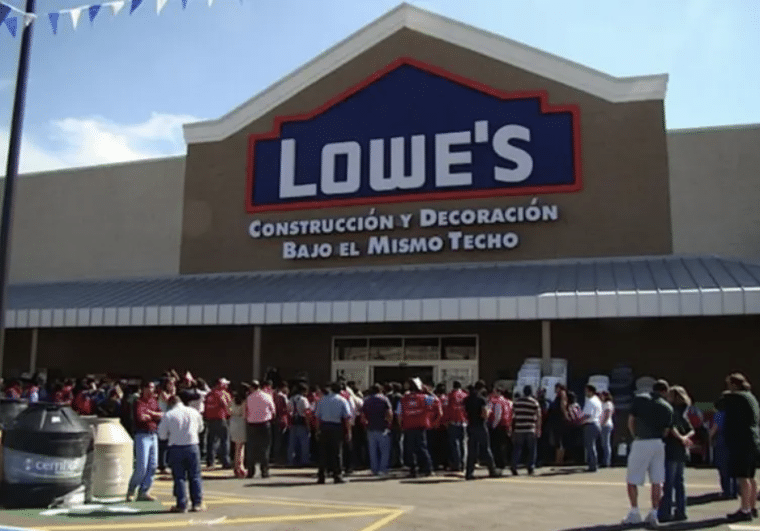
In 2011, Lowe’s was accused of religious intolerance after pulling its advertising from the TLC show All-American Muslim. In response, Lowe’s issued an apology on its Facebook page.
The company took another hit in 2014 when it was ordered to pay a whopping $18.1 million for waste dumping and other environmental violations.
2015 saw Lowe’s open stores in India and in 2016, Lowe’s acquired Rona, a leading Canadian home improvement retailer, for $2.3 billion. The acquisition added a whopping 500 stores to its network, dramatically strengthening its presence in Canada.
In 2017, Lowe’s settled a lawsuit in New Jersey for $2.85 million over allegations of misclassifying over 450 door and window installers as independent contractors, instead of employees.
2018 marked a year of leadership transition and strategic acquisition. Robert Niblock stepped down as CEO, with Lowe’s store count nearly doubling to 2,152 under his tenure. Marvin Ellison assumed the role of president and CEO.
Additionally, Lowe’s acquired Maintenance Supply Headquarters, a distributor of MRO (maintenance, repair, and operations) products to the multifamily housing industry for $512 million.
This move expanded its Pro supply chain and enhanced the company’s ability to serve professional customers. However, Lowe’s also made the decision to exit the Mexican market, closing all 13 stores by 2019.
2020 – Present: Adapting to a Shifting Consumer Landscape
In 2020, Lowe’s launched its Total Home Strategy, becoming a one-stop shop for professionals and DIY enthusiasts. The pandemic fueled a surge in online shopping, and Lowe’s rapidly adapted to meet customer needs.
The company rolled out curbside pickup and touchless pickup lockers along with accelerating its website upgrade to handle a 70% traffic increase. These strategic moves supported strong DIY spending, resulting in over $89 billion in sales throughout the year.
The company celebrated its 100th anniversary in 2021, with 2,197 locations across North America. CNBC reported that 90% of the US population lived within 20 miles of a Lowe’s store. Additionally, Lowe’s joined Fortune’s Top 50 All-Star list of the World’s Most Admired Companies.
In a move to deliver on its Total Home Strategy and maintain its decade-long exclusive position as the only national home improvement retailer to carry Stainmaster carpet, Lowe’s acquired the Stainmaster brand in 2021. The purchase included all brand-related intellectual property, trademarks, and sub-brands.
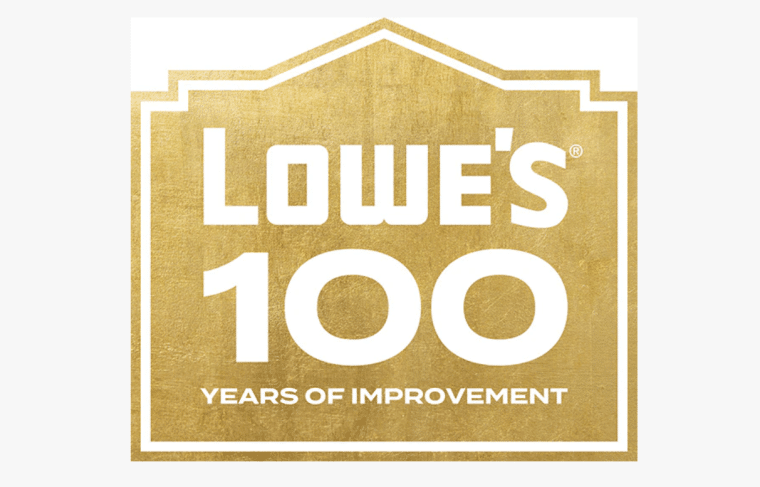
In 2022, Lowe’s extended the Stainmaster brand to include flooring categories beyond carpet and introduced Stainmaster paint as its first private paint brand.
To keep moving with customer expectations, the company also offered two-day standard shipping on most parcel-eligible items. Additionally, Lowe’s announced its goal to reach net-zero emissions by 2050 and committed to significant reductions in its scope 1, 2, and 3 emissions by 2030.
That same year, Lowe’s agreed to pay $700,000 and implement additional measures to settle a lawsuit filed by the US Equal Employment Opportunity Commission (EEOC) over allegations of sexual harassment at its Lake Havasu City location.
In February 2023, Lowe’s completed the sale of its Canadian retail business, officially exiting the market to focus on its domestic operations.
Throughout the year, the company suffered financial strain as DIY customers (who generate 75% of its total sales) allocated fewer dollars to large-scale home remodeling and cut back on discretionary items.
March 2024 saw the home improvement chain launch a loyalty program for do-it-yourself shoppers, giving them a reason to choose Lowe’s more consistently.
The program is set to attract consumers through personalization, ensuring they get discounts relevant to their interests and buying behavior.
How Much Does Lowe’s Pay?
According to its career site, Lowe’s pays between $14 to $25.90 per hour for retail positions. However, the company only lists starting pay ranges for job openings in California, Colorado, Hawaii, New Jersey, New York, and Washington due to state laws.
Meanwhile, according to:
- Glassdoor: The estimated total pay range at Lowe’s is $16–$21 per hour, which includes base salary and additional pay.
- Indeed: The average hourly pay at Lowe’s ranges from $12.49 per hour for a sorter to $25.61 per hour for a maintenance mechanic.
- Payscale: Lowe’s pays employees an average of $14.84 per hour. Operations supervisors make an average hourly rate of $22.75, while cashiers make an average hourly rate of $12.99.
- Zippia: The average hourly wage is $14.52. Software engineers make $60.71 per hour, HR coordinators make $20 an hour, and project specialists make $29.33 per hour.
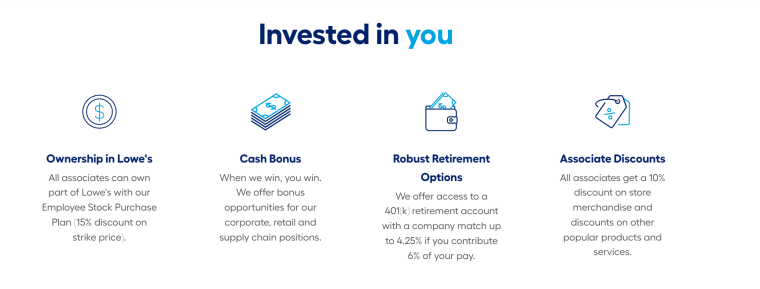
Overall, pay at Lowe’s varies significantly based on store location, the cost of living in the area, experience, and department.
As of February 3, 2023, Lowe’s employed approximately 182,000 full-time associates and 125,000 part-time associates, primarily in the US and India. In terms of benefits, Lowe’s employees get:
- Health, dental, vision, and mental healthcare access.
- 401(k) accounts with up to 4.25% matching on 6% pay contributions; profit-sharing bonuses; 10% employee discount on merchandise; and 15% discounted company stock purchases.
- Tuition-free education assistance for certain programs and the “Track to the Trades” certification assistance program.
Lowe’s has invested more than $3 billion in incremental wages and share-based compensation for front-line associates since 2018. In 2023, the company implemented $170 million in annual wage increases, effective December 2022.
History of the Lowe’s Logo
Lowe’s first logo featured the words “Lowe’s Since 1921” in a bold sans-serif font, followed by “North Wilkesboro Hardware” in a slimmer serif font.
Between 1955 and 1962, Lowe’s logo was updated to feature the word “Lowe’s” in a prominent bold sans-serif typeface. Between 1955 and 1956, the logo incorporated store locations, and very briefly (June-November 1955) the slogan “Everybody Knows You Save At…”.
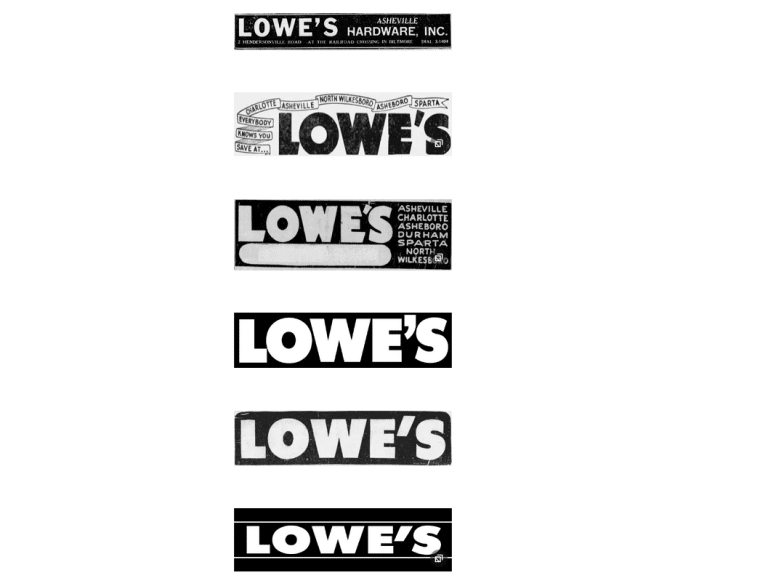
In 1962, the logo was updated to feature striking red and white lettering with a 3D effect. It was paired with a sphere (representing the earth) positioned just behind the first two letters of the word Lowe’s.
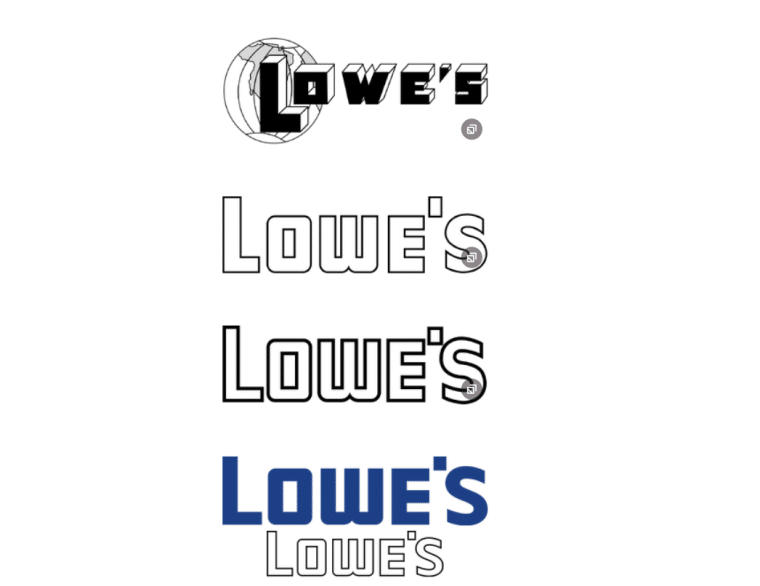
In 1965, the 3D lettering and sphere were dropped in favor of a modern logo featuring the word Lowe’s in a sans-serif font. Variations of this wordmark logo were used until 1997. Thereafter, the logo was updated to feature the brand name in white letters against a dark blue, house-shaped background with a red and grey border and the tagline “Home Improvement Warehouse” in smaller letters.
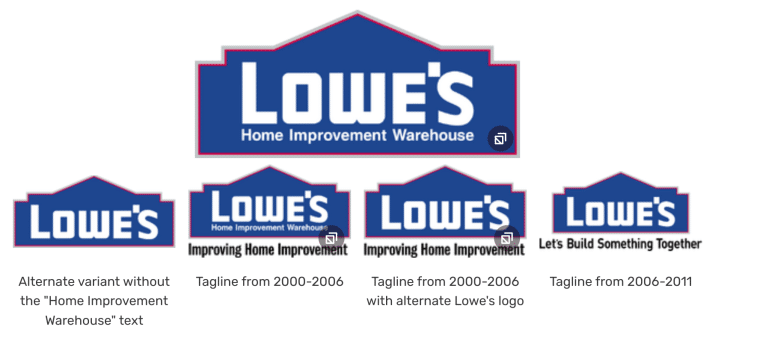
Between 2000 and 2006, the logo was updated to include the slogan “Improving Home Improvement”. From 2006 to 2011, Lowe’s dropped the tagline for a simpler version of the logo which featured a new slogan “Let’s Build Something Together”.
In 2008, the red and grey border and slogan were removed, leaving only the dark blue, house-shaped background. Variations of this logo were used until 2011 when the company adopted the slogan “Never Stop Improving”.
The slogan was updated to “Do it right for less. Start at Lowe’s” in 2019, which was later replaced by “Home to Any Possibility” in 2021, and then “Lowe’s knows home improvement.” in 2023.
Lowe’s Company Highlights
- Origins: Lowe’s started as a family-owned hardware store in North Wilkesboro, North Carolina in 1921.
- Expansion: From a single store, Lowe’s grew to become the world’s second-largest home improvement retailer.
- Strategic Shifts: Shifted focus from contractors to DIY retail customers in 1990.
- Public Listing: Went public in 1961; significant growth in store count and revenue since.
- Leadership: Marvin Ellison, CEO since 2018, led the company to nearly $100 billion in annual revenue.
- Global Presence: Expanded to international markets, including Canada and Mexico.
- Technological Investment: Enhanced customer experience through digital platforms and online services.
The Future of Lowe’s
Established and expanded against the backdrop of World War II, Lowe’s is a beacon of perseverance, consistency, and customer focus. These qualities have positioned the home improvement store chain as a distinct player in the competitive home improvement industry.
For businesses seeking longevity, Lowe’s history holds valuable lessons:
- Adapt to changing market conditions: Lowe’s story highlights the importance of adapting to changing market conditions. From its first store, Lowe’s has consistently updated its offerings and strategies to cater to shifting consumer needs.
- Invest in technology: Lowe’s leverages technology to enhance customer experience and streamline operations. To maintain its edge in the market, Lowe’s continues to invest in digital platforms and in-store innovations.
- Focus on your customers: Lowe’s emphasis on serving the needs of DIY customers and professional contractors alike has been a significant differentiator. By fostering deep relationships with these important segments, the company has managed to maintain a consistent customer base.
With the home improvement sector projected to exceed $600 billion by 2025 (more than double its value in 2008), Lowe’s is well-positioned to leverage lower prices and consumer focus for continued growth and success.
